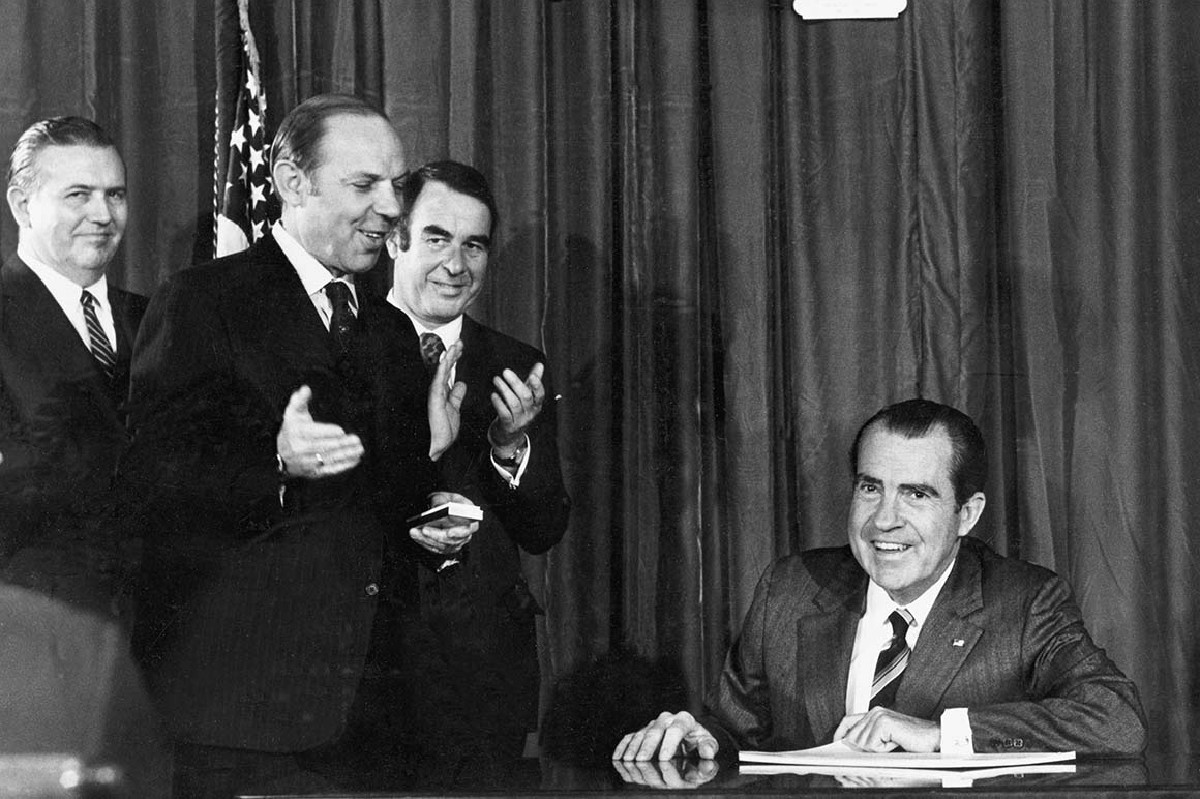Home>Misc>Featured>When Was The Occupational Safety And Health Act Passed


Featured
When Was The Occupational Safety And Health Act Passed
Published: September 12, 2023
Learn about the history of the Occupational Safety and Health Act (Featured), passed to ensure workplace safety. Discover when this crucial legislation was enacted.
Introduction
Welcome to the fascinating world of occupational safety and health! Every day, millions of workers around the globe navigate their workplace environments, facing various hazards and risks. Fortunately, government regulations and acts are in place to ensure their safety and well-being. One such crucial piece of legislation is the Occupational Safety and Health Act (OSHA).
The OSHA is a paramount act that sets the standard for workplace safety and health in the United States. Enacted by Congress in 1970, it plays a vital role in safeguarding the rights of workers and promoting a healthy work environment. This act has significantly impacted industries across the nation, shaping regulations, and improving workplace conditions.
This article will delve into the background information, development, and key provisions of the OSHA, providing an in-depth understanding of its significance. Let’s embark on this journey to explore the path that led to the passage of the OSHA and uncover its transformative impact.
Background Information
Prior to the enactment of the Occupational Safety and Health Act (OSHA) in 1970, workplace safety regulations in the United States were fragmented and inadequate. In the 19th and early 20th centuries, industrialization gave rise to hazardous working conditions, putting workers’ lives at risk. However, it was not until the tragic Triangle Shirtwaist Factory fire in 1911, where 146 garment workers lost their lives, that the need for comprehensive safety measures became evident.
Over the years, various attempts were made to address workplace safety issues, but they were largely ineffective due to the lack of a unified and enforceable framework. Industry was primarily self-regulated, and employers had minimal legal obligations to protect workers from hazards. As a result, thousands of work-related injuries and fatalities occurred annually.
In the 1960s, public concern over workplace safety grew, and worker advocacy groups, unions, and activists called for stronger regulations. Recognizing the urgency to improve occupational safety and health, President Lyndon B. Johnson created a committee to study and make recommendations for a comprehensive federal workplace safety act. This committee’s report laid the foundation for the development of the OSHA.
During the same period, a series of influential disasters, such as the Farmington Mine disaster in West Virginia and the explosion on the Union Oil offshore drilling rig in California, further highlighted the need for urgent action. These incidents reinforced the public’s demand for federal regulations that could prevent such incidents and protect workers’ rights.
The development of the OSHA was also influenced by international initiatives in occupational safety and health. Countries like the United Kingdom, Sweden, and Germany had already established comprehensive safety regulations, setting an example for the United States to follow.
The mounting pressure and public outcry for workplace safety reforms finally led to the OSHA’s creation. In the next section, we will delve into the process that led to the development and passage of this significant piece of legislation.
The Need for Occupational Safety and Health Regulations
The need for comprehensive occupational safety and health regulations cannot be understated. Throughout history, workplaces have been riddled with numerous hazards and risks that pose a threat to workers’ physical and mental well-being. Without proper regulations in place, workers are vulnerable to accidents, injuries, and even fatalities.
One of the primary reasons for the necessity of occupational safety and health regulations is to prevent workplace accidents and injuries. In industries such as construction, manufacturing, and mining, workers face a myriad of hazards, including falls, machinery accidents, chemical exposures, and more. Without appropriate safety measures, these hazards can result in severe injuries or even death. By implementing regulations, employers are mandated to identify hazards, develop safety protocols, and provide appropriate protective measures to minimize the risk of accidents and injuries.
Furthermore, occupational safety and health regulations also play a crucial role in protecting workers from long-term health risks. In many industries, exposure to harmful substances, such as asbestos, lead, and silica, can lead to chronic health issues, including respiratory diseases, cancer, and neurological disorders. By implementing regulations that limit or eliminate exposure to these hazardous substances, workers’ health is safeguarded, reducing the long-term impact on their well-being.
In addition to preventing accidents and long-term health risks, occupational safety and health regulations contribute to the overall well-being and productivity of workers. When employees feel safe and secure in their work environment, their morale and job satisfaction increase. This, in turn, enhances their productivity and performance, leading to improved business outcomes.
Occupational safety and health regulations also play a role in promoting equality and fairness in the workplace. These regulations ensure that all workers, regardless of their background or job position, have the right to a safe and healthy work environment. By enforcing these regulations, employers are compelled to provide the necessary safety training, equipment, and resources to protect their workers, irrespective of their role within the organization.
Lastly, occupational safety and health regulations help to create a culture of safety within organizations. When safety is prioritized and ingrained in the company’s values, it becomes a shared responsibility among employees and employers. This culture of safety encourages proactive hazard identification, reporting, and continuous improvement of safety practices.
The need for occupational safety and health regulations is evident. It is not only about compliance with legal requirements but also about ensuring the well-being of workers and fostering a safe and thriving work environment. In the next section, we will explore the development of the Occupational Safety and Health Act (OSHA) in response to these pressing needs.
The Development of the Occupational Safety and Health Act (OSHA)
The development of the Occupational Safety and Health Act (OSHA) was a significant milestone in the history of workplace safety regulations in the United States. It was the result of years of advocacy, research, and public demand for comprehensive and enforceable occupational safety and health standards.
The process began in the 1960s when President Lyndon B. Johnson established a committee to study the need for federal workplace safety legislation. This committee, known as the National Commission on Industrial Safety (NCIS), conducted extensive research and fact-finding activities to identify the existing gaps and shortcomings in occupational safety and health regulations.
The NCIS report, titled “Accident at Work: A National Study of Occupational Safety and Health,” served as a critical guide for policymakers in drafting the OSHA. The report highlighted the alarming rates of workplace accidents, injuries, and deaths, and emphasized the urgent need for a federal agency responsible for setting and enforcing workplace safety standards.
Influenced by the NCIS report, the U.S. Department of Labor, under the leadership of Secretary of Labor Willard Wirtz, developed a comprehensive legislative proposal to regulate workplace safety and health. This proposal aimed to address the identified gaps by establishing mandatory safety standards, providing training and education, and conducting inspections and enforcement activities to ensure compliance.
The proposed legislation faced significant resistance from industry groups and some members of Congress who argued that it would burden businesses with excessive regulations and cost. However, the push for workplace safety reform gained momentum from public outrage over high-profile workplace accidents and increased public awareness of the hazards faced by workers.
Worker advocacy groups, unions, and grassroots movements played a crucial role in galvanizing public support for the OSHA. Their efforts included organizing rallies, protests, and awareness campaigns to raise public awareness about workplace hazards and the need for stronger regulations.
Ultimately, the public pressure and growing consensus on the need for federal oversight of workplace safety led to the passage of the OSHA. On December 29, 1970, President Richard Nixon signed the OSHA into law, establishing the Occupational Safety and Health Administration as the agency responsible for enforcing workplace safety and health regulations.
The OSHA has since become the cornerstone of workplace safety regulations in the United States, ensuring that employers provide safe and healthy working conditions for their employees. In the next section, we will explore the key provisions of the OSHA and how it has transformed workplace safety and health practices.
Key Provisions of the Occupational Safety and Health Act
The Occupational Safety and Health Act (OSHA) introduced several key provisions that revolutionized workplace safety and health practices in the United States. These provisions form the foundation of OSHA regulations, ensuring the protection of workers and the promotion of safe and healthy work environments.
One of the primary provisions of the OSHA is the establishment of safety and health standards. The Act empowers the Occupational Safety and Health Administration (OSHA) to develop and enforce these standards, which cover a wide range of industries and hazards. These standards set specific requirements for employers to follow, ensuring the protection of workers against various dangers such as chemical exposures, ergonomic hazards, and machinery hazards.
The OSHA also requires employers to provide training and education to their employees. Employers are obligated to train workers on the hazards they may encounter in their roles, as well as the necessary safeguards and precautions to mitigate these hazards. Training programs not only promote awareness but also empower workers to actively participate in maintaining a safe and healthy workplace.
Another crucial provision of the OSHA is the obligation for employers to maintain accurate records of workplace injuries and illnesses. This provision establishes the foundation for effective injury and illness prevention programs. By keeping comprehensive records, employers can track patterns, identify areas of concern, and implement proactive measures to prevent future incidents.
Additionally, the OSHA grants workers the right to request workplace inspections and report hazardous conditions. This provision encourages workers to actively engage in ensuring their own safety and the safety of their peers. Workers can report potential hazards, request OSHA inspections, and participate in the inspection process to address safety concerns and potential violations.
The OSHA also protects workers from retaliatory actions by employers. It prohibits employers from discriminating against employees who exercise their rights under the Act, including reporting hazards or filing complaints. This provision ensures that workers can advocate for their safety without fear of repercussions.
Furthermore, the OSHA promotes collaborative efforts between employers and employees to improve workplace safety. It encourages the establishment of safety and health committees that include representatives from both management and workers. These committees facilitate the communication and cooperation necessary for identifying and addressing safety concerns effectively.
Finally, the OSHA provides for detailed enforcement mechanisms to ensure compliance with its regulations. The Act grants the Occupational Safety and Health Administration (OSHA) the authority to conduct inspections, issue citations and penalties for non-compliance, and even shut down workplaces that pose imminent dangers. These enforcement measures aim to create a strong deterrent against unsafe practices and encourage employers to prioritize the safety and well-being of their workers.
The key provisions of the Occupational Safety and Health Act are essential pillars for improving workplace safety and health. They create a framework that promotes collaboration, awareness, and accountability among employers and workers. By understanding and adhering to these provisions, employers can create safer, healthier, and more productive work environments for their employees.
The Passage of the Occupational Safety and Health Act
The passage of the Occupational Safety and Health Act (OSHA) was a landmark moment in the history of workplace safety regulations in the United States. It marked a significant shift towards ensuring the protection of workers and the enforcement of safety standards across industries.
The OSHA was passed on December 29, 1970, after an extended period of advocacy, research, and public demand for comprehensive workplace safety legislation. It was a result of bipartisan collaboration and recognition of the urgent need for federal intervention in improving working conditions.
The legislative process leading to the passage of the OSHA involved multiple iterations of the bill and intense debates. One of the primary challenges faced during this process was finding common ground between the concerns of industry representatives, who feared excessive regulations, and the demands of worker advocacy groups for stronger protections.
Ultimately, the shared goal of creating safer workplaces bridged the divide. The recognition of the high rates of workplace accidents, injuries, and fatalities, along with public pressure and mounting evidence from research studies, led to a growing consensus among lawmakers that federal legislation was essential.
Alongside this, worker advocacy groups played a crucial role in building public support and raising awareness about workplace hazards. Through protests, grassroots campaigns, and testimonies, they highlighted the urgent need for legislation to protect workers from hazardous conditions.
After months of negotiations and revisions, the OSHA received sufficient support in Congress to pass. It was signed into law by President Richard Nixon, who acknowledged the significance of the legislation in enhancing workplace safety and protecting the well-being of American workers.
The passage of the OSHA represented a significant shift in the approach to workplace safety regulations. It marked the establishment of the Occupational Safety and Health Administration (OSHA) as the federal agency responsible for enforcing safety and health standards. This agency was tasked with developing and implementing regulations, providing support and guidance to employers, conducting inspections, and imposing penalties for non-compliance.
With the passage of the OSHA, it became mandatory for employers to comply with safety standards and provide a safe working environment for their employees. The law reshaped the landscape of workplace safety, shifting it from self-regulation to federal oversight. It provided workers with a clear set of rights and protections, empowering them to actively participate in maintaining their own safety and reporting violations.
The significance of the OSHA’s passage cannot be overstated. It represented a monumental step towards improving workplace safety in the United States and establishing a culture of accountability and responsibility for all stakeholders involved.
In the next section, we will explore the impact and significance of the Occupational Safety and Health Act (OSHA) and how it has transformed workplace safety practices.
Impact and Significance of the Occupational Safety and Health Act
The Occupational Safety and Health Act (OSHA) has had a profound impact on workplace safety practices in the United States since its passage in 1970. It has significantly improved the working conditions of millions of workers and transformed the approach to occupational safety and health across industries.
One of the primary impacts of the OSHA has been the reduction in workplace accidents, injuries, and fatalities. The establishment of safety and health standards, along with the enforcement efforts of the Occupational Safety and Health Administration (OSHA), has led to a significant decline in incidents. Through the implementation of safety protocols and procedures, employers have been able to mitigate known hazards and create safer work environments.
The OSHA’s emphasis on training and education has also played a crucial role in empowering workers and promoting a safety-conscious culture. By providing workers with the necessary knowledge and skills to identify and address hazards, the OSHA’s training initiatives have helped foster a proactive approach to safety. As a result, workers are more aware of the risks around them and are better equipped to prevent accidents and injuries from occurring.
Another significant impact of the OSHA is the increased accountability and responsibility placed on employers. The Act has made it clear that providing a safe and healthy work environment is not just a moral obligation but a legal requirement. This has prompted employers to invest in safety measures, implement comprehensive safety programs, and create a culture of safety within their organizations. As a result, workers have greater confidence in their employers’ commitment to their well-being.
The OSHA’s recordkeeping provision has also had a significant impact on identifying and addressing workplace hazards. By requiring employers to keep records of injuries and illnesses, trends and patterns can be identified, enabling a more proactive approach to identifying and mitigating potential risks. This provision has been instrumental in improving the effectiveness of injury and illness prevention programs, reducing overall workplace health risks.
The OSHA’s impact extends beyond the immediate workplace environment. The Act has raised public awareness about the importance of workplace safety and the rights of workers. It has empowered workers to advocate for their own safety and report hazardous conditions without fear of retaliation. This increased awareness has led to a broader cultural shift, with safety becoming a priority not only within organizations but also in public discourse and social expectations.
Furthermore, the OSHA has influenced global occupational safety and health practices. Its success in establishing a comprehensive regulatory system and promoting worker protections has served as a model for other countries’ safety frameworks. The OSHA’s impact can be seen in the development of similar legislation worldwide and the adoption of its principles by international organizations.
In summary, the Occupational Safety and Health Act (OSHA) has had a transformative impact on workplace safety and health practices in the United States. Through safety standards, training initiatives, enforcement efforts, and increased accountability, the OSHA has enhanced worker protection, reduced workplace hazards, and fostered a culture of safety. Its influence extends beyond national borders, serving as a model for advancing workplace safety globally.
Conclusion
The enactment of the Occupational Safety and Health Act (OSHA) in 1970 marked a crucial turning point in workplace safety regulations. The OSHA has had a lasting impact on improving the safety and well-being of workers across industries in the United States.
The OSHA’s key provisions, such as safety and health standards, training and education, recordkeeping, and enforcement mechanisms, have revolutionized workplace safety practices. They have led to a significant reduction in workplace accidents, injuries, and fatalities, creating safer work environments for millions of workers.
The OSHA’s emphasis on collaboration between employers and employees, as well as the empowerment of workers to actively participate in maintaining their own safety, has fostered a culture of safety and accountability within organizations. It has elevated the awareness of workplace hazards and the importance of implementing preventive measures.
Beyond the impact within the United States, the OSHA has influenced global occupational safety and health practices. Its comprehensive regulatory framework and worker protection principles have served as a model for other countries and international organizations.
However, the work in the realm of occupational safety and health is ongoing. New challenges continue to emerge, demanding innovative approaches and proactive measures to ensure the continuous improvement of workplace safety.
As we move forward, it is vital to maintain the commitment to the principles established by the OSHA and strive for ever higher standards of safety and well-being in the workplace. As employers, employees, and policymakers, we all have a role to play in creating a safe and healthy work environment for everyone.
The journey towards improved workplace safety and health is an ongoing endeavor, and the legacy of the Occupational Safety and Health Act (OSHA) serves as a reminder of the progress we have made and the importance of prioritizing the well-being of workers. By upholding the values and principles embedded in the OSHA, we can continue to shape a future where every worker can thrive in a safe and healthy workplace.









